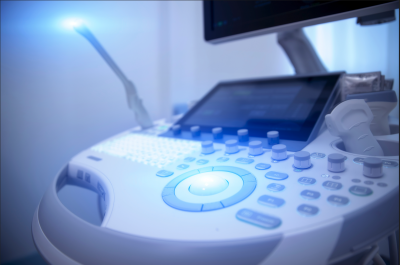
Written by

Cone-beam technology is a relative newcomer to medical diagnostic imaging; until recently it has predominately been used in the world of dental healthcare. It has been marketed to the medical world on a small scale so far, but could it be the ‘next big thing’ in medical imaging?
To understand the differences of this type of imaging, here is a basic overview of the technology: Cone-beam technology scans through single rotation across an angle 360o to produce an anatomical 3D cross-section similar to a CT scan. However, a CT scan rotates multiple times around the patient to form a 3D cross-sectional image. These differences are highlighted in the Table below.
Now, a CT scan is well understood; with the technology producing a full field cross-section of the human body from a helical scan across >360o of the patient. In contrast, a cone-beam scan can produce 3D images of a region of interest (ROI) smaller than the full anatomical cross-section, as well as producing a full field cross-section without a full 360o rotation of the x-ray source and detector.
The question therefore is; is it the x-ray rotation that makes it a CT, or is it the cross-sectional images produced? We suggest this taxonomy:
- To differentiate between CT and cone-beam, one difference is the multiple, rotation of CT scans, versus a single rotation of a cone-beam scan.
- To differentiate between cone-beam CT (CBCT) and cone-beam radiography, the difference is a full field cross-section versus a sub-section, focusing on an ROI.
With or without the language clarifications, the low dose/high resolution diagnostic scope of cone-beam technology is being hailed by manufacturers as a more efficient way of imaging anatomical regions in 3 dimensions. It has been put into practice across a number of medical areas:

Cone-beam Technology In Diagnostic Radiography
Compared to the world of dental radiography, the field of medical ENT (Ear, Nose and Throat) imaging has many similarities; cone-beam technology can be utilised to image a variety of small intricate anatomical structures for diagnostic purposes at a lower dose. A white paper by Soredex highlighted a good example: The placement of cochlear implants into the inner ear is a delicate procedure; in cases when the post-operative performance of the implant was not adequate, cone-beam technology has been used to image the implant in 3 dimensions, to identify the source of the problem.
Another example came from targeted radiotherapy treatment of non-small cell lung cancer (NSCLC), where imaging equipment such as CT and MRI is used to monitor the cancer’s response to treatment. This type of diagnostic imaging is taken at limited time points across the treatment programme because of issues such as cost and x-ray dose risk. During NSCLC treatment, cone-beam technology can be used before each radiotherapy treatment (often a daily routine) to accurately identify the position of the tumour, so that the radiotherapy treatment is targeted for maximum efficacy. Research carried out in a recent study in the Netherlands found that by analysing these images taken during the patient setup, they could more closely monitor the cancer using the cone-beam images in a frequent, lower dose alternative to CT imaging.
As well as the dosimetry issues of conventional CT scans, another challenge is that the patient must be in a supine position for the images to be taken; this becomes a problem when imaging areas of the body which are affected during weightbearing. Carestream Healthcare and Planmed Oy both manufacture cone-beam imaging systems for use on extremities. This technology is being used to image fractures and arthritis while the patient is weight or load-bearing, to visualise the patient’s anatomy under tension.
Cone-beam Technology In Interventional Radiology
Cone-beam technology is not restricted to diagnostic cases; it has also been utilised in the treatment of certain cancers. Siemens have included cone-beam technology within their angiography system since 2004. In 2012 a white paper highlighted the use of cone-beam technology for 3D imaging of the blood vessels which feed a tumour in the liver. These blood vessels are identified using contrast dyes in the blood stream of the patient, and then injected with a chemotherapy drug cocktail, giving targeted treatment to the patient in a procedure called chemoembolisation.
So the cone-beam technology has been used as part of Siemens’ angio systems imaging protocol for some time. More recently it has been used to confirm the accurate placement of stent implantation after a cerebral aneurysm. Siemens’ syngo DynaCT was used to confirm the 3D position of a stent placement procedure across a cerebral aneurysm in the Rush University Medical Centre, Chicago in 2016. In this instance, the images from the cone-beam technology were also used to view the structure of the blood vessels and the aneurysm after the initial stents were placed.
Getting To The Point Of Cone-beam
Regardless of the language, cone-beam technology cannot be discounted as an imaging fad if it’s success in the dental imaging market is anything to go by. Expansion into similar fields like ENT and divergence into interventional imaging and oncology indicate the scope of potential clinical use cases. Having said that, if not clarified, the ambiguity of the language could cause confusion for users and vendors, which may impact market growth.
There are two important features for cone-beam technology that make it a viable alternative to conventional imaging:
- The dosage of x-ray is less in a cone-beam scan than a standard CT scan, but with similar 3D imaging results
- The cone-beam technology not only images full cross-sections of anatomy, but also more specific regions within the patient, such as the ear or liver area, which can be view in better quality images than standard radiography, because of the 3D image.
What is interesting about this technology is that there are some companies who are manufacturing and marketing medical-specific cone-beam technology; such as the Carestream OnSight 3D Extremity System, or Planmed Oy’s Verity, for imaging the extremities. But there are also established manufacturers of the technology for the dental market. In some cases therefore, it will be a rebranding exercise to move cone-beam from dental into the medical market. But these systems may only be applicable for head and neck imaging – what about extremities, or chest x-rays; which makes up the biggest volume in of x-ray imaging?
It seems that the next market to see growth in cone-beam technology will be diagnostic x-ray, the bigger question now is what form will it take? Integrated with conventional general radiography systems, or as a stand-alone system for specific applications. Watch this space.

